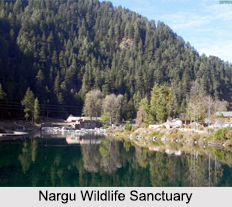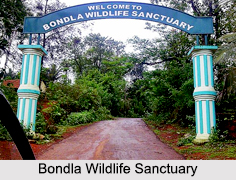 Indian wildlife sanctuaries are homes to diverse wild species. In India, there are around 531 wildlife sanctuaries. These sanctuaries are scattered throughout the country. They cover near about 4.5 percent of the country`s total geographical area. Several Indian national parks were formerly wildlife sanctuaries. There are several Indian wildlife sanctuaries that are serving special purpose of preserving specific species or animals like bird sanctuaries and tiger reserves. Among the wildlife sanctuaries, Project Tiger in India governs about 50 tiger reserves. These reserves hold special significance in the preservation of tigers.
Indian wildlife sanctuaries are homes to diverse wild species. In India, there are around 531 wildlife sanctuaries. These sanctuaries are scattered throughout the country. They cover near about 4.5 percent of the country`s total geographical area. Several Indian national parks were formerly wildlife sanctuaries. There are several Indian wildlife sanctuaries that are serving special purpose of preserving specific species or animals like bird sanctuaries and tiger reserves. Among the wildlife sanctuaries, Project Tiger in India governs about 50 tiger reserves. These reserves hold special significance in the preservation of tigers.
Different Indian Wildlife Sanctuaries
Several Indian wildlife sanctuaries have earned recognition and reputation all over the world and some of them are also counted as the best in the world. Some of the wildlife sanctuaries in north India are Changthang Wildlife Sanctuary (Jammu and Kashmir), Noorichan Wildlife Sanctuary (Jammu and Kashmir), Karakoram Wildlife Sanctuary (Jammu and Kashmir), Nargu Wildlife Sanctuary (Himachal Pradesh) and National Chambal Wildlife Sanctuary (Uttar Pradesh). West India has wildlife sanctuaries like Narayan Sarovar Chinkara Sanctuary (Gujarat), Shoolpaneshwar Wildlife Sanctuary (Gujarat), Thol Wildlife Sanctuary (Gujarat), Anerdam Wildlife Sanctuary (Maharashtra), Bhamragarh Wildlife Sanctuary (Maharashtra), Bhimashankar Wildlife Sanctuary (Maharashtra) and Bondla Wildlife Sanctuary (Goa). A wildlife sanctuary in central India is Bori Wildlife Sanctuary (Madhya Pradesh.Some of the wildlife sanctuaries in east India are Kaimur Wildlife Sanctuary (Bihar), Topchanchi Wildlife Sanctuary (Jharkhand), Bethuadahari Wildlife Sanctuary (West Bengal) and Bhitarkanika Wildlife Sanctuary (Odisha). South India has wildlife sanctuaries like Malai Mahadeshwara Wildlife Sanctuary (Karnataka),Periyar National Park and Wildlife Sanctuary (Kerala), Vedanthangal Wildlife Sanctuary (Tamil Nadu) and Kambalakonda Wildlife Sanctuary (Andhra Pradesh). Some of the wildlife sanctuaries in north east India areBura-Chapori Wildlife Sanctuary (Assam), Laokhowa Wildlife Sanctuary (Assam), Trishna Wildlife Sanctuary (Tripura) and Thorangtlang Wildlife Sanctuary (Mizoram).
Shoolpaneshwar Wildlife Sanctuary (Gujarat), Thol Wildlife Sanctuary (Gujarat), Anerdam Wildlife Sanctuary (Maharashtra), Bhamragarh Wildlife Sanctuary (Maharashtra), Bhimashankar Wildlife Sanctuary (Maharashtra) and Bondla Wildlife Sanctuary (Goa). A wildlife sanctuary in central India is Bori Wildlife Sanctuary (Madhya Pradesh.Some of the wildlife sanctuaries in east India are Kaimur Wildlife Sanctuary (Bihar), Topchanchi Wildlife Sanctuary (Jharkhand), Bethuadahari Wildlife Sanctuary (West Bengal) and Bhitarkanika Wildlife Sanctuary (Odisha). South India has wildlife sanctuaries like Malai Mahadeshwara Wildlife Sanctuary (Karnataka),Periyar National Park and Wildlife Sanctuary (Kerala), Vedanthangal Wildlife Sanctuary (Tamil Nadu) and Kambalakonda Wildlife Sanctuary (Andhra Pradesh). Some of the wildlife sanctuaries in north east India areBura-Chapori Wildlife Sanctuary (Assam), Laokhowa Wildlife Sanctuary (Assam), Trishna Wildlife Sanctuary (Tripura) and Thorangtlang Wildlife Sanctuary (Mizoram).
Significance of Indian Wildlife Sanctuaries
Being the seventh-largest country in the world by geographical region, India has quite a huge natural history and one of the richest wildlife heritages in the world. The Indian subcontinent is a home to many rare, endangered and exotic species of wildlife. A lot of initiatives and measures have been taken to protect the Indian wildlife and to prevent them from extermination. The Indian wildlife sanctuaries are playing an important role in this preservation mission. They keep mammals, animals, reptiles, birds, etc in their natural habitat. Some of the species protected in the sanctuaries are snow leopard, Siberian crane, Asiatic elephant, Indian rhinoceros and royal Bengal tiger. Rock formation, diverse flora and fauna, beautiful landscapes and natural vegetation in these sanctuaries attract tourists from India and all over the world. They witness the wildlife while riding on an elephant`s back or from a watch tower or from a boat. They can spot predators catching their preys, herds of wild elephants and deer. They provide wildlife enthusiasts the chance to explore the rich Indian wildlife and know more about it.



















